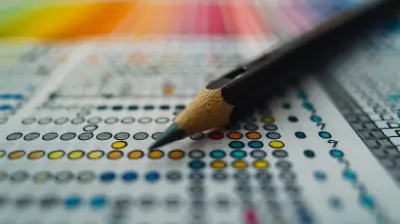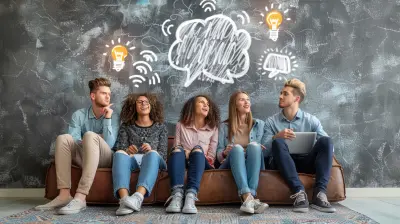28 May 2025
Education is evolving at lightning speed, and if you're still stuck in the "chalk and talk" method, your students are probably tuning out faster than you can say, "Turn to page 42." Enter the flipped classroom—a revolutionary approach that puts traditional learning on its head.
But does it really work? And if so, how can you maximize student engagement using this strategy? Buckle up, because we’re diving deep into flipped classrooms and how to make them a student engagement powerhouse. 
What Is a Flipped Classroom?
A flipped classroom is exactly what it sounds like—flipping traditional teaching methods upside down. Instead of lecturing in class and assigning homework later, teachers provide instructional content (videos, readings, podcasts) beforehand. Then, class time is dedicated to discussions, group work, problem-solving, and hands-on activities.Think of it this way: students digest the basics at home, then come to class ready to apply what they’ve learned. It’s like watching a cooking tutorial before attending a hands-on cooking class—way more effective than watching a chef cook and hoping you remember it later. 
Why Flipped Classrooms Work
Traditional teaching methods often leave students passively absorbing information. They sit, they listen, they (hopefully) take notes. The problem? Learning doesn't stick when it's passive.Flipped classrooms, on the other hand, encourage active learning. Students engage with the material on their own time, and then class becomes an interactive playground where they deepen their understanding. This shift leads to better retention, higher engagement, and improved problem-solving skills.
Let’s break down why flipped classrooms are a game-changer:
1. Students Learn at Their Own Pace
In a traditional lecture, if a student zones out for two minutes, they’ve missed a crucial part of the lesson. In a flipped classroom, students can pause, rewind, and rewatch lessons as many times as needed. No more struggling to keep up—everyone gets to learn at their own speed.2. More Meaningful Classroom Interactions
Instead of spending class time dumping information, teachers can focus on applying concepts through discussions, projects, and critical thinking exercises. Classrooms become collaborative learning environments rather than passive lecture halls.3. Higher Student Engagement
When class time isn’t just about listening to a teacher talk, students actually want to participate. They come prepared with questions, work in groups, and engage in hands-on activities. It transforms learning from a chore into an experience.4. Stronger Teacher-Student Connections
Since teachers aren’t glued to the front of the room delivering lectures, they have more time to interact with students individually. That means more personalized attention, better feedback, and stronger relationships—all of which contribute to student success.
How to Maximize Student Engagement in a Flipped Classroom
Not all flipped classrooms are created equal. Simply assigning a video and hoping for the best won’t cut it. Here’s how you can supercharge student engagement in your flipped classroom:1. Create Engaging Pre-Class Content
Let’s be real—if you assign students a dull 45-minute lecture video, they’re either zoning out or skipping it altogether.Instead, make pre-class content interactive and engaging:
- Use short, high-energy videos (5-10 minutes max)
- Incorporate visuals, animations, and storytelling to make concepts stick
- Provide interactive quizzes or reflection questions alongside the content
- Mix it up with podcasts, infographics, and simulations
The more engaging your content is, the more likely students will actually pay attention and retain what they’ve learned.
2. Hold Students Accountable
If students don’t engage with pre-class materials, the entire flipped model falls apart. Hold them accountable with:- Pre-class quizzes: Quick, low-stakes quizzes ensure students watch and understand the content
- Discussion boards: Require students to post a reflection or question before class
- Group tasks: Assign small collaborative projects based on the material
When students know they’ll have to apply their learning in class, they’ll be more motivated to do the work beforehand.
3. Make Class Time Interactive
Since the lecture portion is out of the way, class time is a golden opportunity for hands-on, student-driven activities:- Case studies and problem-solving exercises
- Group projects and presentations
- Debates, role-playing, and simulations
- Hands-on experiments and real-life applications
The goal? Make learning feel like an experience, not a task.
4. Encourage Peer Collaboration
Students learn best when they teach and learn from each other. Design activities that encourage peer-to-peer learning:- Think-Pair-Share: Students discuss concepts with a partner before sharing with the class
- Jigsaw Method: Each student researches a different part of a topic and teaches their group members
- Collaborative Challenges: Have students solve a real-world problem together
When students collaborate, they stay engaged, build deeper understanding, and develop critical communication skills.
5. Foster a Growth Mindset
Some students might struggle with the flipped model at first—especially if they’re used to spoon-fed learning. Encourage a growth mindset by reinforcing that:- Mistakes are part of the learning process
- Effort leads to mastery
- Asking questions is a sign of engagement, not failure
When students feel supported, they’re more willing to engage, take risks, and push past their comfort zones.
6. Use Technology Wisely
A flipped classroom relies on technology, but tech should enhance, not replace, learning. Use:- LMS platforms (Google Classroom, Canvas, Moodle) for organizing and tracking materials
- Interactive video tools (Edpuzzle, PlayPosit, Nearpod) to embed quizzes into instructional videos
- Gamification (Kahoot, Quizizz, Classcraft) to make learning fun and competitive
Students love technology—so use it strategically to keep them engaged. 
Common Challenges (And How to Overcome Them)
Not everything about flipped classrooms is sunshine and rainbows. Here are some common roadblocks and how to tackle them:1. “My Students Don’t Watch the Videos”
- Keep videos short and engaging- Add quizzes or discussion prompts to ensure accountability
- Make pre-class preparation mandatory for in-class participation
2. “Students Prefer Traditional Lectures”
- Ease into the flipped model gradually- Explain the benefits (more engaging lessons, better understanding, higher grades)
- Collect student feedback and adjust accordingly
3. “Not All Students Have Internet Access at Home”
- Provide alternative formats (USB, printed materials, offline videos)- Offer before/after school access to computers
- Partner with local libraries or community centers for resources
4. “It’s a Lot of Work for Teachers”
- Start small—flip one lesson at a time- Use pre-made resources instead of creating everything from scratch
- Collaborate with other teachers to share materials
Final Thoughts: Is the Flipped Classroom Worth It?
Absolutely. When done right, flipped classrooms lead to deeper learning, higher engagement, and better overall outcomes. Students walk into class prepared, active, and engaged, instead of zoning out while a teacher drones on.But here’s the catch—it’s not just about flipping the order; it’s about flipping the mindset. If you’re willing to put in the effort to create dynamic pre-class materials, hold students accountable, and design engaging in-class activities, the results will speak for themselves.
So, are you ready to flip the script on learning?








Emmeline Gonzalez
Thank you for sharing such insightful strategies on flipped classrooms! Your tips on maximizing student engagement are practical and inspiring. I'm excited to implement these ideas in my own teaching practice to foster a more interactive learning environment for my students.
November 14, 2025 at 5:25 AM